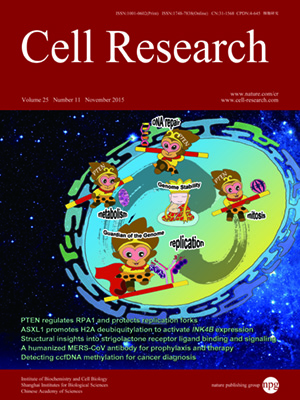
Volume 25, No 11, Nov 2015
ISSN: 1001-0602
EISSN: 1748-7838 2018
impact factor 17.848*
(Clarivate Analytics, 2019)
Volume 25 Issue 11, November 2015: 1265-1268
LETTERS TO THE EDITOR
Implication of cell-in-cell structures in the transmission of HIV to epithelial cells
Chao Ni1,*, Lei Huang3,*, Yuhui Chen1,*, Meifang He4, Yazhuo Hu1, Siyang Liu5, Xiangdong Fang6, Jingyun Li5, Qiang Sun2 and Xiaoning Wang1
1School of Bioscience and Bioengineering, South China University of Technology, Guangzhou, Guangdong 510006 & Institute of Life Sciences & Municipal Key Laboratory of Geriatric, Chinese PLA General Hospital, the State Key Laboratory of Kidney, Beijing 100853, China
2Institute of Biotechnology, 20 Dongdajie, Beijing 100071, China
3302 Military Hospital of China, Beijing 100039, China
4The First Affiliated Hospital, Sun Yat-Sen University, Guangzhou, Guangdong 510080, China
5Beijing Institute of Microbiology and Epidemiology, Beijing 100071, China
6Beijing Institute of Genomics, Chinese Academy of Sciences, Beijing 100101, China
Correspondence: Qiang Sun, E-mail: sunqiang@bmi.ac.cn; Xiaoning Wang(xnwang88@163.com)
Chronic virus infection, such as infection by Epstein-Barr virus (EBV), hepatitis B/C virus (HBV/HCV) and human immunodeficiency virus (HIV), constitutes major public health concerns. Although efforts in deciphering the mechanisms underlying their virological consequences have greatly improved clinical prevention and therapy, various challenges, such as virus tropism drifting, remain to be addressed to develop effective clinical interventions. While cell-free viruses usually infect target cells via binding to specific receptors, the presence of virions in non-susceptible cells has been reported with the mechanisms poorly understood1. Recently, we reported that EBV could infect non-susceptible nasopharyngeal epithelial cells (ECs) through the formation of cell-in-cell structures between ECs and internalized B lymphocytes that have been infected with EBV. This novel mechanism was termed in-cell infection2. Given the formation of similar heterotypic cell-in-cell structures between other EC-lymphocyte pairs, such as epithelial tumor cells and T lymphocytes3, we wonder whether in-cell infection also plays a role in mediating transmission of other viruses.
10.1038/cr.2015.119
FULL TEXT | PDF
Browse 1927


